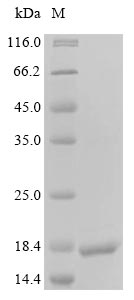Glycoprotein Ibalpha (GP1BA) is a crucial protein involved in platelet function and hemostasis. It encodes the GPIbα subunit of the GPIb-IX-V complex, which acts as a receptor for von Willebrand factor (VWF) [1]. This interaction with VWF is essential for platelet adhesion and aggregation, playing a pivotal role in primary hemostasis [2]. GP1BA is also known to bind to a wide array of ligands in addition to VWF, indicating its multifaceted role in platelet function.
Furthermore, GP1BA is implicated in various platelet-related disorders. Gain-of-function mutations in the GP1BA gene have been associated with Platelet-type von Willebrand disease (PT-VWD), an autosomal dominant platelet function disorder [3]. Additionally, GP1BA mutations have been described in Bernard-Soulier syndrome, a rare inherited bleeding disorder characterized by thrombocytopenia and unusually large platelets [4]. These findings underscore the significance of GP1BA in maintaining normal platelet function and hemostasis.
Moreover, GP1BA has been identified as a key player in platelet adhesion and aggregation processes. It forms the GPIb complex, which interacts non-covalently with other subunits to facilitate platelet adhesion and activation [5]. Studies have also highlighted the role of GP1BA in collagen receptor-mediated platelet activation, emphasizing its involvement in physiological processes beyond VWF binding [6].
References:
[1] Z. Nagy, T. Vögtle, M. Geer, J. Mori, S. Heising, G. Nunzioet al., "The gp1ba-cre transgenic mouse: a new model to delineate platelet and leukocyte functions", Blood, vol. 133, no. 4, p. 331-343, 2019. https://doi.org/10.1182/blood-2018-09-877787
[2] E. Favaloro, "Phenotypic identification of platelet-type von willebrand disease and its discrimination from type 2b von willebrand disease: a question of 2b or not 2b? a story of nonidentical twins? or two sides of a multidenominational or multifaceted primary-hemostasis coin?", Seminars in Thrombosis and Hemostasis, vol. 34, no. 1, p. 113-127, 2008. https://doi.org/10.1055/s-2008-1066019
[3] M. Othman, H. Kaur, E. Favaloro, D. Lillicrap, J. Paola, P. Harrisonet al., "Platelet type von willebrand disease and registry report: communication from the ssc of the isth", Journal of Thrombosis and Haemostasis, vol. 14, no. 2, p. 411-414, 2016. https://doi.org/10.1111/jth.13204
[4] J. Ma, Z. Chen, G. Li, H. Gu, & R. Wu, "A novel mutation in gp1ba gene in a family with autosomal dominant bernard soulier syndrome variant: a case report", Experimental and Therapeutic Medicine, vol. 21, no. 4, 2021. https://doi.org/10.3892/etm.2021.9791
[5] M. Minkov, P. Zeitlhofer, A. Zoubek, L. Kager, S. Panzer, & O. Haas, "Novel compound heterozygous mutations in two families with bernard–soulier syndrome", Frontiers in Pediatrics, vol. 8, 2021. https://doi.org/10.3389/fped.2020.589812
[6] J. Shen, X. Chen, W. Li, Q. Han, C. Chen, J. Luet al., "Identification of parkinson’s disease-related pathways and potential risk factors", Journal of International Medical Research, vol. 48, no. 10, p. 030006052095719, 2020. https://doi.org/10.1177/0300060520957197






